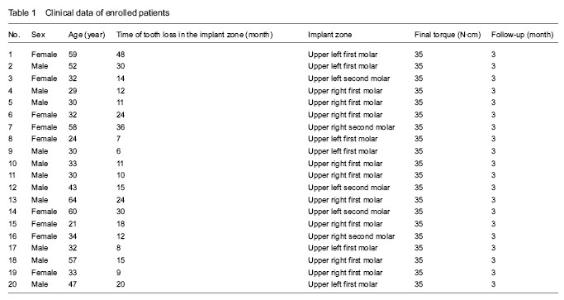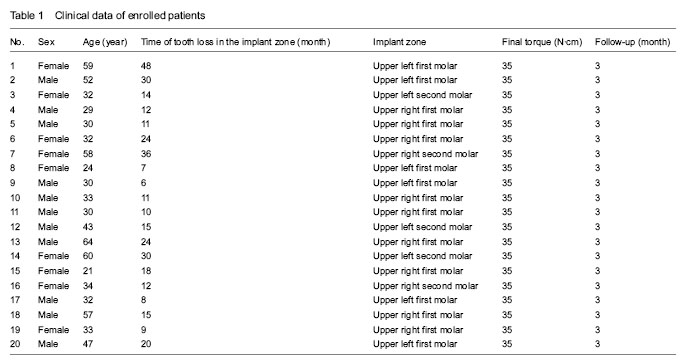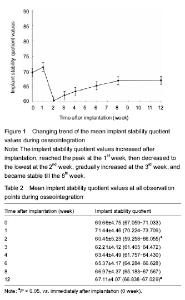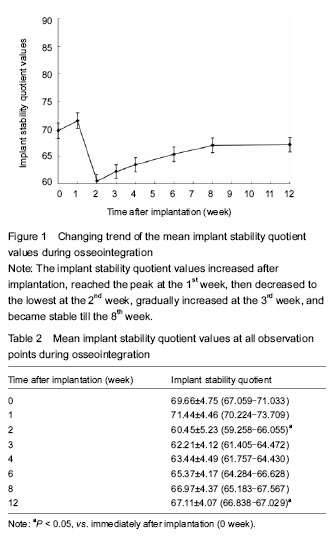| [1] |
Huo Hua, Cheng Yuting, Zhou Qian, Qi Yuhan, Wu Chao, Shi Qianhui, Yang Tongjing, Liao Jian, Hong Wei.
Effects of drug coating on implant surface on the osseointegration
[J]. Chinese Journal of Tissue Engineering Research, 2021, 25(22): 3558-3564.
|
| [2] |
Zhang Xuan, Li Yunpeng, Zhang Xuejian, Yin Chuanrong, Deng Yue.
Guided bone regeneration using preformed titanium mesh combined with bioabsorbable membranes in aesthetic area
[J]. Chinese Journal of Tissue Engineering Research, 2020, 24(26): 4112-4117.
|
| [3] |
Liu Dan, Min Changqin, Lu Shuai, Chen Yue, Sun Yong.
Osseointegration induced by beta-tricalcium phosphate loaded with advanced platelet-rich fibrin
[J]. Chinese Journal of Tissue Engineering Research, 2019, 23(6): 888-893.
|
| [4] |
Li Fang, Cheng Yuting, Huang Xiaolin, Zhou Qian, Wu Chao, Shi Qianhui, Wang Yong, Liao Jian.
Maxillary sinus floor augmentation: with or without bone grafting
[J]. Chinese Journal of Tissue Engineering Research, 2019, 23(6): 971-977.
|
| [5] |
Zou Yingnan, Wang Yibo, Ding Chao, Pan Xinyu, Shi Jiuhui .
Three-dimensional finite element analysis of dental implant combined with residual tooth after hemisection under dynamic loads
[J]. Chinese Journal of Tissue Engineering Research, 2019, 23(2): 178-183.
|
| [6] |
Wang Liping, Chen Weihong, Zha Jun, Chen Xili, Su Yucheng, Fang Ying, Dong Yu, Guo Xueqi, Ge Linhu.
Short-term efficacy evaluation of Mis Seven implant system repairing dentition loss
[J]. Chinese Journal of Tissue Engineering Research, 2019, 23(14): 2208-2214.
|
| [7] |
Li Ying, You Yapeng, Li Baoe, Song Yunjia, Ma Aobo, Chen Bo, Han Wen, Li Changyi.
Type I collagen combined titanium dioxide nanotube composite coating modified titanium surface improves osteoblast adhesion and osseointegration
[J]. Chinese Journal of Tissue Engineering Research, 2019, 23(14): 2169-2176.
|
| [8] |
Wei Wei, Shu Jing-ai, Wang Jing, Zheng Li-xia, Li Lu, Wang Qing-shan.
Application of hydroxyapatite functional graded biomaterials in human hard tissue replacement
[J]. Chinese Journal of Tissue Engineering Research, 2018, 22(6): 971-978.
|
| [9] |
Liu Ou, Gao Zhu, Li Tao, Zhou Bo.
Minocycline hydrochloride ointment is available for the treatment of peri-implantitis
[J]. Chinese Journal of Tissue Engineering Research, 2018, 22(6): 852-857.
|
| [10] |
Chang Lijun, Tang Tian, Zhang Xiaoge.
Periodontal tissue changes in a Beagle dog model of peri-implantitis under orthodontic force
[J]. Chinese Journal of Tissue Engineering Research, 2018, 22(34): 5464-5468.
|
| [11] |
Wang Zhong-da, Wang Yi-bo, Ding Chao, Shi Jiu-hui.
Three-dimensional finite element analysis of implant denture for anterior tooth missing with different arch shapes
[J]. Chinese Journal of Tissue Engineering Research, 2018, 22(30): 4818-4823.
|
| [12] |
Ma Yan, Zhang Hua, Shang Jian-ping, Jiang Qi.
Acid etching and anodic oxidation of titanium surface of nanotubes promotes the proliferation and osteogenesis of bone marrow mesenchymal stem cells
[J]. Chinese Journal of Tissue Engineering Research, 2018, 22(29): 4614-4619.
|
| [13] |
Lin Yi, Tao Xian-fa, Wang Yi-bo, Ding Chao, Xing Jian-yu, Xu Ran, Shi Jiu-hui.
Three-dimensional finite element analysis of splinted crown restoration of molars with different implant platform positions
[J]. Chinese Journal of Tissue Engineering Research, 2018, 22(26): 4123-4127.
|
| [14] |
Liu Li-ping, Lv Xiao-fei, Deng Shu, Peng Cheng .
Biomechanical finite element analysis on the bone interface of posterior mandibular area under different setting forces after inclined implantation with angled abutment
[J]. Chinese Journal of Tissue Engineering Research, 2018, 22(2): 196-203.
|
| [15] |
Ma Ming, Wan Rong-xin, Lv Xiao-fei, Chu Shan-shan, Li Li-jun, Gu Han-qing, Peng Cheng.
Preparation and biological properties of TiN/Ag composite coating on pure titanium surface
[J]. Chinese Journal of Tissue Engineering Research, 2018, 22(2): 189-195.
|



